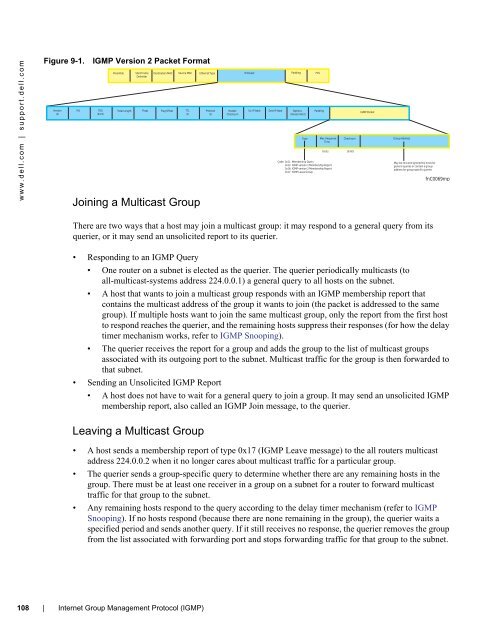8.3.17.0 - Force10 Networks
8.3.17.0 - Force10 Networks
8.3.17.0 - Force10 Networks
Create successful ePaper yourself
Turn your PDF publications into a flip-book with our unique Google optimized e-Paper software.
www.dell.com | support.dell.com<br />
Figure 9-1. IGMP Version 2 Packet Format<br />
Version<br />
(4)<br />
IHL TOS<br />
(0xc0)<br />
Preamble Start Frame<br />
Delimiter<br />
Total Length Flags Frag Offset<br />
Joining a Multicast Group<br />
There are two ways that a host may join a multicast group: it may respond to a general query from its<br />
querier, or it may send an unsolicited report to its querier.<br />
• Responding to an IGMP Query<br />
• One router on a subnet is elected as the querier. The querier periodically multicasts (to<br />
all-multicast-systems address 224.0.0.1) a general query to all hosts on the subnet.<br />
• A host that wants to join a multicast group responds with an IGMP membership report that<br />
contains the multicast address of the group it wants to join (the packet is addressed to the same<br />
group). If multiple hosts want to join the same multicast group, only the report from the first host<br />
to respond reaches the querier, and the remaining hosts suppress their responses (for how the delay<br />
timer mechanism works, refer to IGMP Snooping).<br />
• The querier receives the report for a group and adds the group to the list of multicast groups<br />
associated with its outgoing port to the subnet. Multicast traffic for the group is then forwarded to<br />
that subnet.<br />
• Sending an Unsolicited IGMP Report<br />
• A host does not have to wait for a general query to join a group. It may send an unsolicited IGMP<br />
membership report, also called an IGMP Join message, to the querier.<br />
Leaving a Multicast Group<br />
• A host sends a membership report of type 0x17 (IGMP Leave message) to the all routers multicast<br />
address 224.0.0.2 when it no longer cares about multicast traffic for a particular group.<br />
• The querier sends a group-specific query to determine whether there are any remaining hosts in the<br />
group. There must be at least one receiver in a group on a subnet for a router to forward multicast<br />
traffic for that group to the subnet.<br />
• Any remaining hosts respond to the query according to the delay timer mechanism (refer to IGMP<br />
Snooping). If no hosts respond (because there are none remaining in the group), the querier waits a<br />
specified period and sends another query. If it still receives no response, the querier removes the group<br />
from the list associated with forwarding port and stops forwarding traffic for that group to the subnet.<br />
108 | Internet Group Management Protocol (IGMP)<br />
Destination MAC Source MAC Ethernet Type IP Packet Padding<br />
TTL<br />
(1)<br />
Protocol<br />
(2)<br />
Header<br />
Checksum<br />
Src IP Addr<br />
Dest IP Addr Options<br />
(Router Alert)<br />
FCS<br />
Padding<br />
Type Max. Response<br />
Time<br />
Code: 0x11: Membership Query<br />
0x12: IGMP version 1 Membership Report<br />
0x16: IGMP version 2 Membership Report<br />
0x17: IGMP Leave Group<br />
Checksum<br />
8 bits 16 bits<br />
IGMP Packet<br />
Group Address<br />
May be zero and ignored by hosts for<br />
general queries or contain a group<br />
address for group-specific queries<br />
fnC0069mp
















